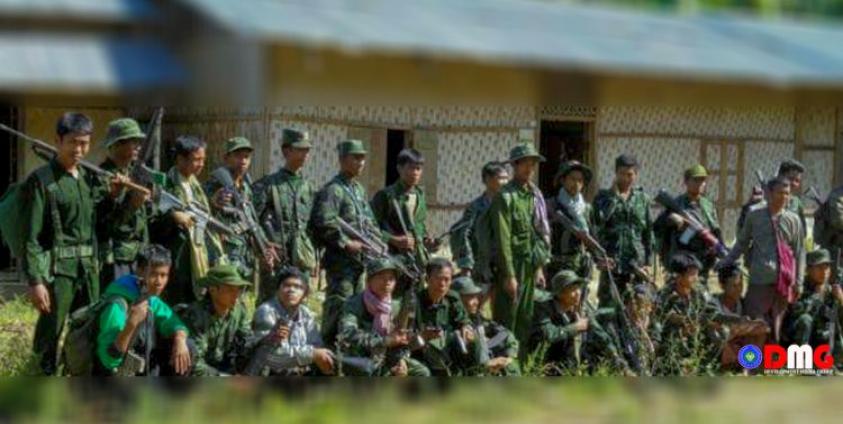Maung Tun Kyaing — The Myanmar military, which considers itself the strongest institution in Myanmar, has been struggling for months to crush the resistance movement that sprang up since its 2021 coup, and is fiercely attacking the ethnic armed organisations (EAOs) that refuse to hold talks.
Myanmar’s military regime — which holds as paramount the Three Main National Causes (non- disintegration of the Union, non-disintegration of national solidarity and perpetuation of sovereignty), the Nationwide Ceasefire Agreement (NCA), and the 2008 Constitution — this year told NCA signatories that they would be allowed to keep their arms, provided they join the military or its affiliated Border Guard Forces (BGFs).
The idea could be seen as a shrewd ploy to lure the EAOs’ political wings into participating in the election that the regime plans to hold next year. Junta chief Senior-General Min Aung Hlaing also offered them an incentive; that his regime would provide assistance in line with the law if they want to do business.
Following a grouped meeting with leaders of the Pa-O National Liberation Army, the Lahu Democratic Union and the Arakan Liberation Party, the regime had an informal meeting with them, urging them to join the Myanmar military or BGF, according to a report from Voice of America.
This might prompt EAOs that are either small in size or enjoy less popularity among the people to consider joining the military or BGF.
ALP on Horns of a Dilemma
The ALP and its armed wing, the Arakan Liberation Army (ALA), were formed at a Buddhist monastery in Yangon’s Kamayut Township on April 9, 1967, to fight for the equality, liberation and self-determination of Arakanese people.
More than 60 years after its establishment, the ALP is still struggling, based now on the Bangladeshi and Thai-Myanmar borders. It has not grown in size in all those years, and remains a small armed group, with just 100 members.
The ALP engaged in peace talks with the U Thein Sein government in 2012, and signed the NCA on October 15, 2015. The party leadership, however, failed to bring up a younger generation of members. The result is the party is not active on the ground, and out of touch with Arakanese people.
Despite its status as a long-time Arakanese revolutionary group, the party has been holding peace talks with the regime that tormented many Arakanese people during two years of fighting from the end of 2018 to late 2020, on the subject of federalism, which the Myanmar military has not wanted to talk about at all until relatively recently.
A key factor is the support of Arakanese people. It is the Arakan Army (AA) and its political wing, the United League of Arakan, which currently enjoy popular support in Arakan State.
The AA’s ambition is to achieve sovereignty for the Arakanese people. Apart from its 30,000- member strong army, which makes the AA one of the most powerful EAOs in Myanmar, it has created a parallel administration that calls itself the Arakan People’s Authority (APA), complete with its own judicial branch and system of taxation. Overall, the APA’s administrative mechanism is proving to be successful across Arakan State.
Calling its revolution the “Way of Rakhita,” the ethnic armed group revealed its Arakan Dream 2020 in the year prior. It has achieved a certain level of success in solidifying Arakanese communities across the world in their buy-in of the Arakan Dream.
Taking lessons from the past, the AA/ULA is striving for the liberation of Arakanese people, and confederate status for Arakan as a territory. From the end of 2018 to November 2020, the Myanmar military launched an offensive against the AA using a significant portion of its air, navy and ground forces, but still the AA grew in strength.
Fatigue eventually set in for the armies of both sides, and the fighting in Arakan State was halted for more than a year by an informal ceasefire, but now the fighting has been renewed. There are fresh clashes in northern Arakan State and in Paletwa Township, Chin State, an area along the India-Myanmar border. Helicopter gunships and jet fighters are being used by the Myanmar military, at times, to attack AA positions.
This second round of fighting between the military and the AA is seen to be so far centred on strategies of controlling Myanmar’s borders with Bangladesh and India. When you think about it in context, if the ALP becomes a border guard force as has reportedly been offered by the military, it is inevitable that it will have to face the AA in the Maungdaw region.
Tensions Between AA and ALP
Relations between the AA and ALP have been strained for years. Since the AA came to the India-Bangladesh-Myanmar border from Kachin State’s Laiza to establish a commanding presence in Arakan State in 2015, it has been at odds with the ALP, which was clearly first to gain a foothold in the region. However, with the understanding of the leaders of both sides, there was no voice of public indication of discomfort between the two Arakanese armed groups for years. Then, in August 2017, due to unresolved tensions between the two groups, fighting broke out and the AA took over the ALP headquarters.
The Arakan Army arrested Lieutenant Colonel Khaing Paw Lin, an executive committee member of the ALP, not because he was a member of the ALP but because of alleged crimes committed against the Arakanese people, according to AA spokesman U Khaing Thukha. The AA has since detained several members of the ALP.
There are also questions as to whether the military junta is setting up a game as a strategy to widen the cracks between the two Arakanese revolutionary groups. In the past, EAOs have been used by military authorities to take advantage of their differences.
In 2009, military leaders brought together EAOs such as the Democratic Karen Buddhist Army (DKBA), New Democratic Army – Kachin (NDA-K) and Pa-O National Organization (PNO/A) to transform them into BGFs under the military command structure.
The DKBA under Colonel Saw Chit Thu in Kayin State was transformed into a BGF in 2009, and received regular rations from the military and was allowed to run its businesses. As the DKBA joined forces with the Myanmar military and attacked the Karen National Union (KNU), there were instances where the army was able to attack several important camps along the Thai border, including the KNU headquarters in Manerplaw.
Therefore, the main characteristic of the BGFs is that they automatically fall under the command and control of the Tatmadaw.
A Long History
Over the course of Myanmar’s modern history, peace talks have had many tricks included, with both sides of any given relationship trying to produce a beneficial result for themselves. It can be said that the result has been divisions based on strength.
Under the guise of exchange of arms and peace, ethnic forces under the junta’s control have been consistently disarmed and surrendered, rather than seeing the revolution they once espoused through to its conclusion. After studying these processes, I have related thoughts about the ALP, which is currently discussing with the military junta. If ALP officials don’t accept it and continue to deal with the military junta with this context in mind, the future path remains bleak; peace talks that have no answer.
If the ALP were to agree to a fundamental transformation of the BGF system under which it was incorporated by the military, it would still have to contend with the currently growing influence of the AA. In the past, military leaders intervened to fight back and provide support to groups that had broken away from ethnic armed groups or were in conflict with each other, but the scope of the uprising against the 2021 coup is too great for that to happen these days.
The Anti-Coup Crowd
The AA remains on the other side, rejecting the peace talks offered by the military junta and opposing the military coup. The AA has gained influence in part by establishing an administration, judiciary and security apparatus in the state that runs parallel to the junta’s own.
Criticisms of the ALP among Arakanese people regarding its peace talks with the military junta are now commonplace, and some Arakanese civil society groups have also objected. Despite the lack of popular support, the ALP continues to hold peace talks with the military junta.
In summary, the ALP’s perceived position as an apparent piece on the military junta’s chess board will remain challenging for all stakeholders. The future course of the military junta’s dream of turning the ALP into a fully fledged BGF unit and the ALP’s stated goal of Arakanese unity, alongside the prospect of fresh conflict with the AA, will continue to be watched with
much interest.








